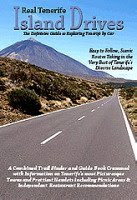Enjoying a lively Christmas lunch in the courtyard of a museum party was a fittingly surreal topping to the last few weeks in Tenerife.
Exploding Tapas in Puerto de la Cruz
The period had started bizarrely enough when we took my sister and her boyfriend, who were on holiday in Playa de la Arena on a tapas route around the town. Some great tapas dishes were tested; however, the one which got the best reaction wasn’t the tastiest, but the oddest. Ravioli filled with space dust in Casa Pache was quite unlike anything I’d ever tasted. No wonder they called it ravioli sorpresa.
Volcanic Eruptions on Tenerife
The 18th of November saw the centenary of the last eruption on Tenerife at Chinyero above Santiago del Teide. We went along to see how it was being celebrated and stood on the edge of the volcano as a load of suits, looking completely inappropriately dressed for trekking across a lava field, posed for photos with Ricardo Melchior, the Island’s President (who was at least dressed for the countryside). The event also coincided with the opening of Santiago del Teide’s new cultural centre set in and around the lovely old buildings of Casa El Patio. We’d first clocked the building about three years before, when its estimated opening date was already 6 months behind schedule. In Tenerife time that’s not bad. On maps of Puerto de la Cruz, the car park at the harbour has been identified as ‘futuro parque marítimo’ for about 20 years.
Chestnuts, Wine and Street Sliders
This year’s arrastre de las tables, where local lads scream down steep streets to celebrate San Andrés in Icod de los Vinos was a bit of a washout. Much more enjoyable was partaking of a poke of chestnuts and some new vino tinto around the harbour in Puerto… if you could get a seat. It’s the sort of thing that Puerto does brilliantly. The smells, tastes and sounds were a reminder that for anyone wanting to sample the real Tenerife and do the sort of things that Canarios enjoy doing, Puerto’s hard to beat.
Yellow Weather Alerts on Tenerife #1 The Rain
November is always a dodgy month on Tenerife. It’s the month that the rains can return with a vengeance after the long dry summer. We always advise people that if they’re coming to Tenerife for only a week and want some sunshine, don’t come to the north in November or February. The rains don’t normally last long, but when they come you know about them. This year’s were the worst we’d seen since we moved here and although they only lasted about 24 hours, they left chaos in their wake and destroyed part of the town beach.
Christmas on Tenerife
The Christmas lights in Puerto this year are a bit of a disappointment. They’re very nice and tasteful, but lack a bit of colour. Thank goodness then for a completely over the top psychedelic big wheel, whose frantically whizzing neon lights dominate the town’s skyline. The funfair in Puerto’s harbour is part and parcel of Christmas here, as are aisles full of turrón in the supermarket – we’re on our third packet of the season.
Snow on Mount Teide
They were a bit late in coming and they didn’t stay long, but the first snows of the year fell on Mount Teide’s slopes last week. We’re hoping that more falls during the next week so that we can say we’ve had a white Christmas on Tenerife.Yellow Weather Alerts on Tenerife #2 The Waves
Some people panic when they hear there’s a weather alert on Tenerife, but when the alerts for big waves, it’s more of a heads up to experience nature’s show than to batten down the hatches. Last week I was hoping to see some surfers tackling ‘El Bravo’, but although the waves turned up as promised, the surfers didn’t… hey ho.
Christmas is almost upon us, so with Christmas concerts during the next week, New Year’s celebrations and the Tres Reyes parades there are a few things that we’re looking forward to before the fiesta season starts again in January.
Feliz Navidad Todos





















































